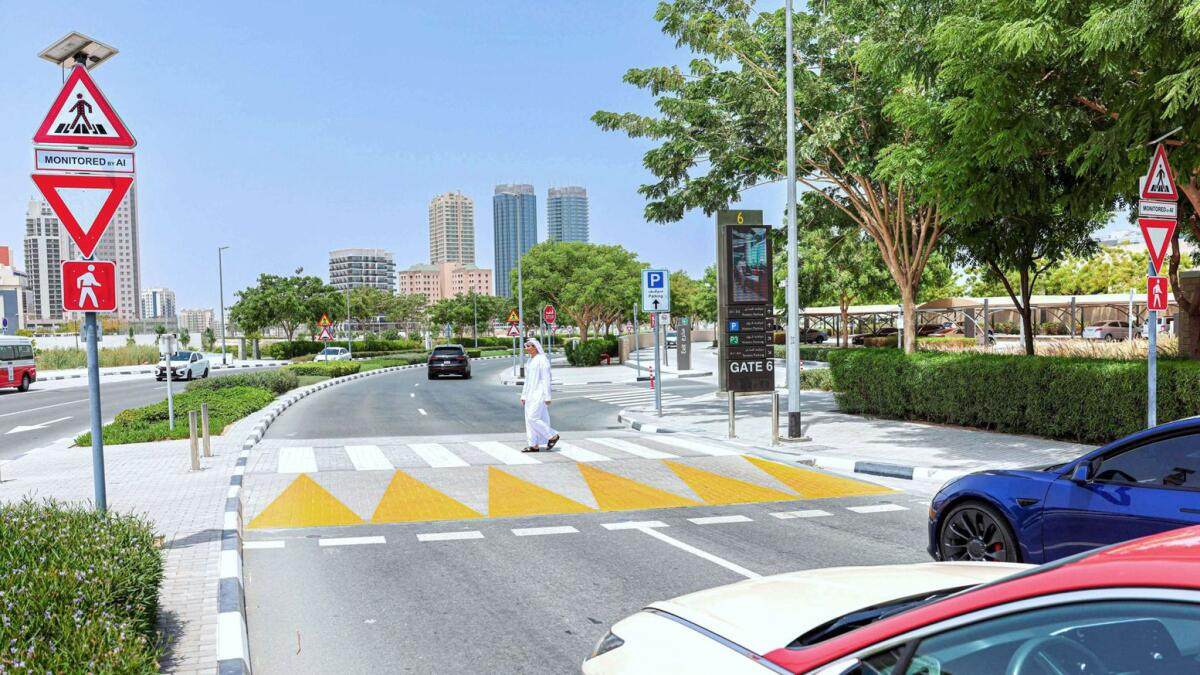In the bustling streets of Dubai Silicon Oasis (DSO), a cutting-edge technological advancement has emerged to address pedestrian safety concerns. Fourteen smart pedestrian crossing systems, leveraging the power of artificial intelligence (AI), have been deployed to detect and protect vulnerable road users. Developed by Derq, these systems incorporate behavior prediction models, flashing warning signs, in-road warning lights, and traffic signal controllers to anticipate and prevent potential conflicts with approaching vehicles. This article explores how these AI-powered systems work, the benefits they offer, and their potential impact on road safety.
Understanding the AI-Powered Pedestrian Crossing Systems
The smart pedestrian crossing systems in DSO are equipped with sophisticated algorithms that continuously monitor the crosswalk area. Using real-time perception and connectivity, the AI platform can identify pedestrians, cyclists, and other vulnerable road users. By tracking the movement of vehicles and road users approaching the crosswalk, the system optimizes reaction times for approaching vehicles, maximizing safety for pedestrians.
Real-Time Perception and Connectivity
The backbone of these smart pedestrian crossing systems is the AI platform, which relies on real-time perception and connectivity. The system’s sensors and cameras capture live data of the crosswalk area, enabling it to make informed decisions in real-time. This connectivity also allows the system to communicate with traffic signal controllers, in-road warning lights, and flashing warning signs.
Behavior Prediction Models
One of the unique features of these AI-powered systems is the use of behavior prediction models. Drawing from vast amounts of data and machine learning, the system can predict the movements and intentions of pedestrians and other road users. This predictive capability enables the system to proactively activate warnings and alerts before any potential conflicts occur.
Maximizing Effectiveness and Customization
The effectiveness of the smart pedestrian crossing systems lies in their ability to adapt to various crossing scenarios and road conditions. The flexibility to activate or deactivate alerts and control their duration ensures a customized approach to different situations.
Customized Alert Duration
Alerts generated by the system can be tailored to specific crossing scenarios. For instance, in busy intersections, the system can keep the alert active for a predetermined crossing time. On the other hand, in less crowded areas, alerts can be configured to remain active only as long as a pedestrian is detected in the crosswalk or its vicinity.
Enhancing Safety for Vulnerable Road Users
The AI-powered system prioritizes the safety of vulnerable road users, such as children, elderly individuals, and cyclists. By accurately detecting their presence and predicting their behavior, the system ensures that approaching vehicles are adequately alerted, reducing the likelihood of accidents.

Deriving Insights from Data
Beyond its real-time safety functions, the smart pedestrian crossing systems also collect valuable data to improve road safety and traffic performance. This data-driven approach enables relevant authorities to make informed decisions and take proactive measures to address safety concerns.
Data Collection for Road Users’ Awareness
The system captures and analyzes data related to road users’ movements and crossing patterns. This information sheds light on pedestrian and cyclist behaviors, allowing authorities to understand their needs and implement infrastructure changes accordingly.
Traffic Performance Analysis
The data collected by the smart pedestrian crossing systems also includes traffic flow and performance metrics. By analyzing this data, authorities can identify traffic bottlenecks and optimize traffic signal timings, contributing to smoother and safer traffic flow.
The Role of 5G in AI-Powered Crossing Systems
The implementation of ultra-high speed and low-latency 5G connectivity adds another layer of efficiency and functionality to the AI-powered pedestrian crossing systems.
Enabling Data Collection and Communication
The 5G connection facilitates seamless data collection from the sensors and cameras deployed across the crosswalk area. This real-time data stream is essential for the AI platform to make timely decisions and activate warnings as needed.
Remote Operation and Maintenance
With 5G capabilities, the system’s operator can remotely manage and maintain the smart crossing systems. This remote access ensures prompt troubleshooting and updates, reducing downtime and ensuring continuous functionality.
Safety Information for Connected Vehicles
In the future, the smart pedestrian crossing systems are poised to communicate directly with connected vehicles approaching the crosswalk. Through 5G communication technologies, the system can relay safety information and alerts, further enhancing road safety.
FAQs
How do the AI-powered pedestrian crossing systems work?
The systems use real-time perception and connectivity to detect pedestrians, cyclists, and other vulnerable road users. The AI platform tracks approaching vehicles and road users, optimizing the reaction time of vehicles and activating warnings to prevent potential conflicts.
Can the alert duration be customized?
Yes, the systems offer the flexibility to customize alert duration based on specific crossing scenarios. Alerts can remain active for a predetermined crossing time or as long as a pedestrian is detected in the crosswalk or its vicinity.
What is the role of behavior prediction models in these systems?
Behavior prediction models leverage data and machine learning to anticipate the movements and intentions of pedestrians and other road users. This predictive capability enables the system to proactively activate warnings before conflicts occur.
How does the system enhance safety for vulnerable road users?
By accurately detecting the presence and behavior of vulnerable road users, the system ensures that approaching vehicles are adequately alerted, reducing the likelihood of accidents involving pedestrians, children, elderly individuals, and cyclists.
What data does the system collect?
The smart pedestrian crossing systems collect data on road users’ movements and crossing patterns, as well as traffic flow and performance metrics. This data is used to improve road safety and optimize traffic signal timings.
How does 5G connectivity contribute to the systems?
5G connectivity enables real-time data collection, remote operation, and maintenance of the smart crossing systems. In the future, it will also facilitate communication of safety information to connected vehicles approaching the crosswalk.
Conclusion
The deployment of fourteen smart pedestrian crossing systems powered by AI in Dubai Silicon Oasis marks a significant advancement in road safety technology. These systems, equipped with behavior prediction models and 5G connectivity, exemplify how AI can be harnessed to protect vulnerable road users and improve overall traffic safety. As data collection and analysis continue, these smart crossing systems have the potential to set new benchmarks for road safety not only in Dubai but also in other communities worldwide. The fusion of AI and road safety is a promising frontier, paving the way for safer and more efficient urban mobility in the future.



























